Have a Seat
by Bob Brooke
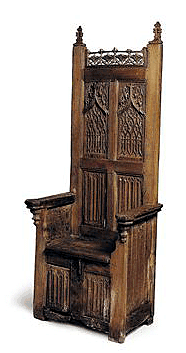 “Have a seat.” That’s a
common expression today. But back in the 15th century, that honor, at
least in a formal chair was relegated to royalty and the higher clergy.
At that time, important people----kings, queens, government officials,
and bishops and cardinals—got to sit in comfort in a heavy chair or
throne. Everyone else sat on stools or benches. “Have a seat.” That’s a
common expression today. But back in the 15th century, that honor, at
least in a formal chair was relegated to royalty and the higher clergy.
At that time, important people----kings, queens, government officials,
and bishops and cardinals—got to sit in comfort in a heavy chair or
throne. Everyone else sat on stools or benches.
People take chairs for granted today. They appear everywhere in a wide
variety of styles, sizes, and comfort levels. However, it took centuries
for chairs to evolve into the ubiquitous seating of today.
For centuries, chairs were articles of state and dignity rather than an
article of ordinary use. The chest, the bench and the stool were until
then the ordinary seats used in everyday living.
Rulers and ecclesiastics used chairs as a seat of authority. A chair
stood at the head of the lord’s table, on his dais, and by the side of
his bed. This usually had a high back, sometimes had a canopy, and a
front and sides enclosed with paneled or carved wood. The seat was often
hinged and locked with a key.
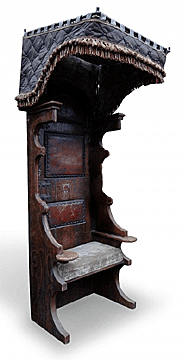 During the Renaissance in Europe, chairs ceased to be a privilege of
state, and became customary for those who could afford them. Almost at
once, chairs began to reflect the fashion trends of the day. During the Renaissance in Europe, chairs ceased to be a privilege of
state, and became customary for those who could afford them. Almost at
once, chairs began to reflect the fashion trends of the day.
One example is the “conversation chair,” designed for men wearing
expensive laced coats in the 18th century. A gentleman could then sit
with his face to the back, his valuable tails hanging unimpeded over the
front.
Side chairs and armchairs, which were really side chairs with wood arms
attached, offered little choice when it came to comfort. In addition to
solid-backs, there were slat-back chairs, which had three or more wide
and usually shaped wooden pieces horizontally across the back. The
banister-back chair had fairly wide vertical slats
surmounted by a crest or top rail. Chairmakers richly carved some of
these top rails, as well as the banisters.
Until the middle of the 17th century, chairmakers constructed chairs of
oak without upholstery. Later, they made leather cushions for the seats
to make them more comfortable. Eventually, they began covering the seat
cushions with velvet and silk.
Nearly all 17th-century chairs were massive and solid, and thus of
considerable weight.
It wasn’t until the introduction of the Louis XIII chairs with cane
backs and seats that chairmakers were able to make them less cumbersome.
French chairmakers went on to create the bergere chair, a high-fashion
chair made of walnut that became popular among the nobility.
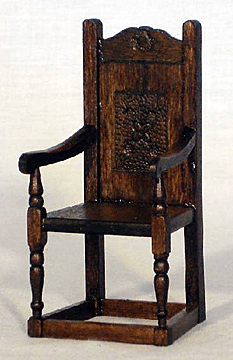 Meanwhile, the English chairmakers across the Channel had no time for
frivolous and exotic designs. This was especially the case up until the
end of the Tudor Period, after which France began to set her mark upon
the British chair. The squat chair, with its heavy back, carved like a
piece of paneling, gave way to a taller, more slender, and more elegant
form, in which chairmakers carved only the framework. Meanwhile, the English chairmakers across the Channel had no time for
frivolous and exotic designs. This was especially the case up until the
end of the Tudor Period, after which France began to set her mark upon
the British chair. The squat chair, with its heavy back, carved like a
piece of paneling, gave way to a taller, more slender, and more elegant
form, in which chairmakers carved only the framework.
The latter part of the 17th Century, technically known as the
Restoration Period in England, brought forth lighter and more adaptable
chairs. Special turnings, scrolled and more elaborate stretchers, became
fashionable. Decorations expanded to include lacquer, marquetry, and
some inlay.
 Chairmakers of the Restoration especially focused on the chair
stretcher. From a mere cross-bar intended to strengthen the
construction, the stretcher blossomed into an elaborate scroll-work or a
graceful semicircular ornament connecting all four legs, with a
vase-shaped knob in the center. Chairmakers of the Restoration especially focused on the chair
stretcher. From a mere cross-bar intended to strengthen the
construction, the stretcher blossomed into an elaborate scroll-work or a
graceful semicircular ornament connecting all four legs, with a
vase-shaped knob in the center.
They also added scrolls and spirals to the arms and legs, as well as to
a chair’s back splat. Popularized in England by the cavaliers who had
been in exile with Charles II, these forms degenerated into something
much stiffer and more rectangular, with a solid, more or less
fiddle-shaped splat and a cabriole leg with pad feet during the reign of
William and Mary. The more ornate chairs had cane seats and
ill-proportioned cane backs.
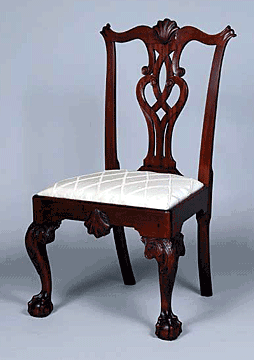 Thomas Chippendale studied these forms when he created his now famous
Chippendale chair, with its elaborately interlaced back, its graceful
arms and square or cabriole legs, the latter terminating in the ball and
claw or padded foot. George Hepplewhite, Thomas Sheraton and Robert Adam
all aimed at lightening the chair, which, even in the master hands of
Thomas Chippendale, remained comparatively heavy. They succeeded and
gave modern chairs a much lighter design. Thomas Chippendale studied these forms when he created his now famous
Chippendale chair, with its elaborately interlaced back, its graceful
arms and square or cabriole legs, the latter terminating in the ball and
claw or padded foot. George Hepplewhite, Thomas Sheraton and Robert Adam
all aimed at lightening the chair, which, even in the master hands of
Thomas Chippendale, remained comparatively heavy. They succeeded and
gave modern chairs a much lighter design.
The wing chair appeared before 1700. It was probably the first
comfortable chair and certainly the first upholstered one. The wings
attached to the frame of the back served the same purpose as hangings on
a bed—they cut off drafts. Earlier, settees had been no more than wooden
benches with arms and backs. Between 1660 and 1690, sofas began to
appear with covered arms and backs.
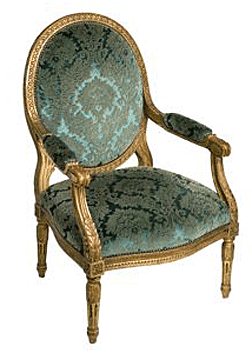 But times and fashions changed. Informal manners and a new
half-reclining posture replaced the former bolt-upright demeanor of
court and aristocracy in the age of Louis XIV. Chairmakers responded
with new commodious seat furniture, developed in Paris around 1720. They
upholstered these new Rococo chairs by building removable frames that
could be secured by clips, so that servants could change them easily
from winter to summer use. Servants stored the off-season upholstered
frames in the Crown Furniture Repository in the Hotel du Garde Meuble.
These early Louis XV chairs have backs upholstered, with the back in a
flat panel that was ordinarily placed squared to the wall, so that the
top-rails' curves complemented those of the carved wood panels behind
them. But times and fashions changed. Informal manners and a new
half-reclining posture replaced the former bolt-upright demeanor of
court and aristocracy in the age of Louis XIV. Chairmakers responded
with new commodious seat furniture, developed in Paris around 1720. They
upholstered these new Rococo chairs by building removable frames that
could be secured by clips, so that servants could change them easily
from winter to summer use. Servants stored the off-season upholstered
frames in the Crown Furniture Repository in the Hotel du Garde Meuble.
These early Louis XV chairs have backs upholstered, with the back in a
flat panel that was ordinarily placed squared to the wall, so that the
top-rails' curves complemented those of the carved wood panels behind
them.
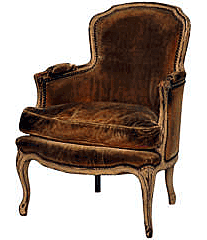 French fashions in chairs radiated from Paris. From the late 1720s,
chairmakers constructed fashionable Louis XV French chairs without
stretchers, which interfered with the unified flow of curved seatrails
into cabriole legs that generally ended in scroll feet. According to
strict guild regulations in force until the Revolution, French
chairmaking was the business of the joiner, whose craft was often
combined with that of the upholsterer, both of whom specialized in
seat-furniture-making. French fashions in chairs radiated from Paris. From the late 1720s,
chairmakers constructed fashionable Louis XV French chairs without
stretchers, which interfered with the unified flow of curved seatrails
into cabriole legs that generally ended in scroll feet. According to
strict guild regulations in force until the Revolution, French
chairmaking was the business of the joiner, whose craft was often
combined with that of the upholsterer, both of whom specialized in
seat-furniture-making.
Joiners developed a variety of specialized seats and gave them fanciful
names, of which the comfortable bergère or "shepherdess" is the most
well known. They used beechwood, painted with clear light tones that
matched those used on a room’s wall paneling, or gilded them. If joiners
used a natural finish, they chose walnut. Outside of Paris, joiners used
fruitwoods for chairmaking.
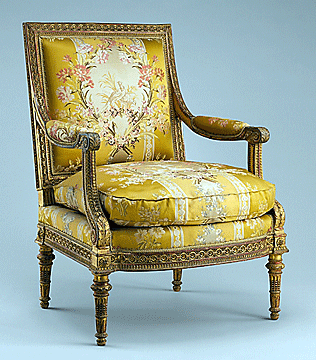 By the late 1760s in Paris, joiners began making the first Parisian
neoclassical chairs, even before the accession of Louis XVI, whose name
became associated with this style. Straight tapering fluted legs joined
by a block at the seat rail and architectural moldings, characterize the
style, in which each element is a discrete entity. Three of the leading
French chairmakers from the 1770s to the 1780s were Louis Delanois,
Jean-Claude Sené and Georges Jacob. By the late 1760s in Paris, joiners began making the first Parisian
neoclassical chairs, even before the accession of Louis XVI, whose name
became associated with this style. Straight tapering fluted legs joined
by a block at the seat rail and architectural moldings, characterize the
style, in which each element is a discrete entity. Three of the leading
French chairmakers from the 1770s to the 1780s were Louis Delanois,
Jean-Claude Sené and Georges Jacob.
Most historians agree that the 18th century was the golden age of the
chair, especially in France, England, and Colonial America. Chairmakers
from all three locations exchanged ideas. The period reached its
stylistic peak in the typical Louis XVI chair, with its oval back and
ample seat, descending arms and round-reeded legs, and upholstered in a
tapestry woven with Boucher or Watteau-like scenes. The Empire also had
some squat chairs, which though comfortable enough, showed no
inspiration.
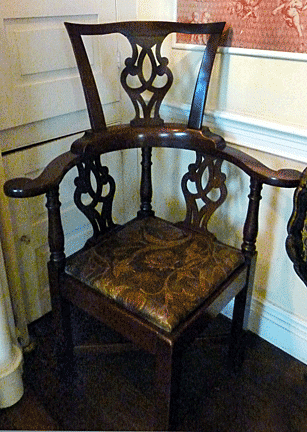 A radically different style of chair appeared during the Queen Anne
period that was called the corner or roundabout chair. This had a low
back that encircled two sides of the seat, the latter placed diagonally
so that it formed a right-angled corner. All chairs had a softly curving
structure, for they were shaped to fit the body. Side chairs and wooden
armchairs often had a high, shaped back with one wide, vase-shaped
splat. A radically different style of chair appeared during the Queen Anne
period that was called the corner or roundabout chair. This had a low
back that encircled two sides of the seat, the latter placed diagonally
so that it formed a right-angled corner. All chairs had a softly curving
structure, for they were shaped to fit the body. Side chairs and wooden
armchairs often had a high, shaped back with one wide, vase-shaped
splat.
Simple rocking chairs began appearing in America in the early part of
the 18th century. However, the production of wicker rocking chairs
didn’t reach its peak until the mid 18th century.
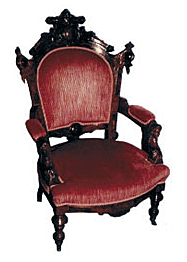 The 19th century brought with it a variety of furniture revival styles.
During the Victorian Era, there were no less than seven major furniture
styles, many of which overlapped. Furniture suites began to appear in
the latter part of the century, each with chairs to match. Several of
these styles reflected some of the periods above, including Rococo and
Renaissance Revival. The 19th century brought with it a variety of furniture revival styles.
During the Victorian Era, there were no less than seven major furniture
styles, many of which overlapped. Furniture suites began to appear in
the latter part of the century, each with chairs to match. Several of
these styles reflected some of the periods above, including Rococo and
Renaissance Revival.
But by the end of the 19th century, furniture makers looked to the
simpler styles of the 20th century to counteract the overly decorated
ones of the Victorian Era. The Art Nouveau style produced beautiful
chairs influenced by the forms of nature while the Arts and Crafts
Movement produced heavy, straight-lined chairs devoid of ornamentation.
To read
more of my articles, please
visit
my Web site.
< Back to Antiques Articles
Next Article >
|
